Stay in the know on all smart updates of your favorite topics.
Who should win the Dutch Applied AI Award?

Last year, during the Month of the AAI in November, the Centre of Expertise Applied Artificial Intelligence (AUAS - Amsterdam University of Applied Sciences) presented the Dutch Applied AI Award for the first time. This year we are back for a second edition. The award is part of the Computable Awards and is for suppliers of AI solutions, start-ups in the AI field and good examples of the implementation of AI.
This award is jointly organized with AUAS, Computable and podcast De Dataloog . You can nominate an individual or organisation, based on a project you think has stood out in the past 12 months. The projects may have been particularly successful, innovative or extensive.
You can nominate until 16 August 2021
The winner will be announced on 2 November 2021 during a spectacular show in the Jaarbeurs Utrecht. Last year, healthcare platform DEARhealth won the Dutch Applied AI award. Who will walk away with the prize this year? 🙌🏻
About the Computable Awards
This will be the 16th year in a row that Computable will present the Computable Awards in November 2021. These prizes are awarded to companies, projects and individuals who, according to Computable readers, have clearly distinguished themselves in the past year.
An independent jury of experts will select five nominees for each award from the nominated parties. The ranking by the jury and the number of votes from Computable readers each determine half of which nominee will receive the award in November. The number of times a party is nominated for a nomination does not play a role, but the quality of the substantiation and information about the project mentioned does.
PODCAST Groen & Gezond Almere: Jim van der Wardt over ondernemen, verbinden en Makers van Almere

In deze aflevering spreekt presentatrice Nadia Zerouali Almeerder Jim van der Wardt. Hij zag een kans om een beweging in de stad die al bestond, maar nog niet zichtbaar was, een podium te geven. Onder de noemer Makers van Almere bracht hij de makers in de stad digitaal samen én bij de mensen thuis.
Zelf is hij ook een ondernemende maker in de stad en brengt met zijn duurzame uitgangspunt een oude ambacht weer tot leven. Hoe hij dit allemaal doet, ontdekken we in deze aflevering. Hij is te luisteren op Spotify, Apple Podcasts & Soundcloud!
Ben je nieuwsgierig naar wat er verder allemaal gebeurd op het gebied van duurzaamheid in Almere? Je kunt het duurzaamheidsprogramma van de gemeente Almere volgen via groenengezond.almere.nl of via Instagram, Facebook, Twitter en LinkedIn onder Groen en Gezond Almere.
Heb je nog ideeën voor deze podcast, een tip of iets aardigs? We horen heel graag van je. Laat een reactie achter via je favoriete podcast app of in de comments.
Metropolitan Mobility Podcast!

Chris Bruntlett (Dutch Cycling Embassy) and Geert Kloppenburg are looking back at the Celebrating Cycling Cities event and our interviews with mobility experts from all over the world! Listen to the best practices and who we would like to speak next: https://bit.ly/mobilitypod
Beyond the smart city: Digital innovation for the Good of citizens

About ten years ago, technology companies started to provide cities with technology, luring them with the predicate ‘smart(er)’, a registered trademark of IBM. At that time Cisco's vice-president of strategy Inder Sidhudescribed the company’s ‘smart city play’ as its biggest opportunity, a 39,5 billion dollar-market. During the years, that followed, the prospects rocketed: The consultancy firm Frost and Sullivan estimated the global smart city technology market to be worth $1.56 trillion by 2020.
The persistent policy of technology companies to suggest a tight link between technology and the wellbeing of the citizens, angers me. Every euro these companies are chasing at, is citizens’ tax money. What has been accomplished until now is disappointing, as I documented in the IET Journal. According to The Economist it is not surprising that a ‘techlash’ is underway: Many have had it with the monopolistic dominance of behemoths like Google, Amazon, Facebook and the like, because of their treatment of sensitive data, the lack of transparency and accountability of algorithm-based decision making and the huge profits they make from it.
Regaining public control
However, let's not throw out the baby with the bathwater and see how digital innovation can be harnessed for the Good of all citizens. Regaining public control demands four institutional actions at city level.
1. Practicing governance
Before even thinking about digitalization, a city must convert into best practices of governance. Governance goes beyond elections and enforcing the law. An essential characteristic is that all citizens can trust that government represents their will and protects their interests. Therefore, it is necessary to go beyond formal democratic procedures and contact stakeholders directly, enable forms of participatory budgeting and deploy deliberative polling.
Aligning views of political parties and needs and wants of citizens takes time and a lot of effort. The outcome might be a common vision on the solution of a city’s problems and the realisation of its ambitions, and a consecutive political agenda including the use of tools, digital ones included.
2. Strengthening executive governmental power
Lack of cooperation within the departmental urban organizations prevents not only an adequate diagnosis of urban problems but also the establishment of a comprehensive package of policy instruments, including legislation, infrastructure, communication, finance and technology. Instead, decisions are made from within individual silos, resulting in fragmented and ineffective policies. Required is a problem-oriented organization instead of a departmental one and a mayor that oversees the internal coherence of the policy.
3. Level playing field with technology companies
Cities must increase their knowledge in the field of digitization, artificial intelligence in particular. Besides, but they should only work with companies that comply with ethical codes as formulated in the comprehensivemanual, Ethically Aligned Design: A Vision for Prioritizing Human Well-being with Autonomous and Intelligent Systems, drafted by the influential Institute of Electric and Electronic Engineers (IEEE)
Expertise at city level must come from a Chief Technology Officer who aligns technological knowledge with insight in urban problems and will discuss with company representatives on equal foot. Digitalisation must be part of all policy areas, therefore delegating responsibility to one alderman is a bad idea. Moreover, an alderman is not an adequate discussion partner for tech companies.
4. Approving and supporting local initiatives
Decentralization of decision-making and delegating responsibility for the execution of parts of the policy to citizen’s groups or other stakeholders helps to become a thriving city. Groups of citizens, start-ups or other local companies can invoke the right of challenge and might compete with established companies or organizations.
In summary: steps towards seamless integration of digitalization in citizen-orientated policy
1. Define together with citizens a vision on the development of the city, based on a few central goals such as sustainable prosperity, inclusive growth, humanity or - simply - happiness.
2. Make an inventory of what citizens and other stakeholders feel as the most urgent issues (problems and ambitions).
3. Find out how these issues are related and rephrase them if desirable.
4. Deepen insight in these issues, based on available data and data to be collected by experts or citizens themselves.
5. Assess ways to address these issues, their pros and cons and how they align with the already formulated vision.
6. Make sure that digital technology has been explored as part of the collected solutions.
7. Investigate which legal, organizational, personnel and financial barriers may arise in the application of potential solutions and how to address them.
8. Investigate undesired effects of digital techniques, in particular long-term dependence ('lock-in') on commercial parties.
9. Formulate clear actions within the defined directions for dealing with the issues to be addressed. Involve as many expert fellow citizens as possible in this.
10. Make a timetable, calculate costs, and indicate when realization of the stated goals should be observable.
11. Involve citizens, non-governmental and other organizations in the implementation of the actions and make agreements about this.
12. At all stages of the process, seek support from those who are directly involved and the elected democratic bodies.
13. Act with full openness to all citizens.
I can't agree more than with the words of Léan Doody (smart city expert Arup Group): I don't necessarily think 'smart' is something to strive for in itself. Unlike sustainability or resilience, 'smart' is not a normative concept…. The technology must be a tool to deliver a sustainable city. As a result, you can only talk about technological solutions if you understand which problems must be solved, whether these problems are rooted in the perceptions of stakeholders and how they relate to other policy instruments.
Urban Mobility: Cycling transitions in two major European cities

After approximately 15 podcast interviews with experts from around the world, it's time for researcher/advisor/podcastmaker Geert Kloppenburg to look back at the best practices. He started 2,5 years ago with the idea to just contact people in the cities who are actually implementing changes in the streets at this moment. He has discovered so many great best practices that he would like to share.
Geert visited different cities around the world to interview experts on cycling and mobility and noticed an explosion in cycling. And when Corona came, the use of bicycles grew even more.
In this interview Geert looks back on 15 podcast and video interviews on the transformation of different cities.
Watch the 9 minute video and let us know what you think.
Note from ASC: What are your thoughts after watching 👀? Let us know bellow.
Hoogbouw vraagt om een menselijke maat nu steden verdichten

HvA-onderzoeksproject Sensing Streetscapes deelt eindresultaten en gaat op excursie naar vier steden met ontwerpoplossingen op ooghoogte.
De populariteit van de stad zet alsmaar door, en dat is te zien aan huidige bouwprojecten. Die gaan steeds meer de hoogte in nu de stad verdicht. Van Londen tot Oslo en van Vancouver tot Amsterdam. Lectoraat Bouwtransformatie van de Hogeschool van Amsterdam (HvA) onderzocht met ontwerpbureaus, gemeenten, ontwikkelaars en woningbouwcorporaties binnen onderzoeksproject Sensing Streetscapes hoe je een menselijke maat kan creëren in gebiedsontwikkeling met hoge dichtheden. De onderzoekers zetten hiervoor ontwerpend onderzoek, neuroarchitectuur en AI in. Welke lessen voor de praktijk leverden dit 2-jarige onderzoek op en tot wat voor inzichten kwamen de experts rondom dit actuele vraagstuk?
De onderzoekers binnen het actieonderzoek Sensing Streetscapes analyseerden in Amsterdam, Vancouver, Toronto, Manchester, Londen en Oslo de toegepaste ontwerpoplossingen om hoogbouw te verschalen naar menselijke proporties op ooghoogte. Omdat zowel de ontwerpopgave als de methodiek van neuroarchitectuur nieuw zijn voor Nederland werkten zij samen met internationale partners en steden. De analyses tonen de gerealiseerde oplossingen voor dezelfde stedenbouwkundige regels. Grote verschillen werden hierdoor zichtbaar.
Kijken als professional: zes casestudies ontwerpend onderzocht
Terwijl Toronto zich manifesteert met extreme en harde keuzes die de hoogbouw letterlijk aan de straat tonen, is er in onder meer Vancouver, Manchester en Amsterdam veel meer gelaagdheid. Bovendien zijn er meer details toegepast waarmee de hoogbouw visueel minder nadrukkelijk aanwezig is voor de gebruikers in de straat. En dat is nodig, want een menselijke maat op straatniveau verbetert de leefbaarheid op hoogbouwlocaties en verhelpen gezondheids- en stressklachten gerelateerd aan deze milieus.
De Zuidas in Amsterdam als ‘mixed-use’ gebied is een voorbeeld waar de hoogbouw goed werkt, vertelt Frank Suurenbroek, lector Bouwtransformatie bij het Centre of Expertise Urban Technology van de HvA, tijdens een excursie door de Zuidas. ‘De verbinding tussen de zakelijkheid van kantoren en de zachte materialen voor woningbouw is hier grotendeels geslaagd. Daarnaast is er veel groen door mooie pocket parks (kleine parken), die deels toegankelijk zijn voor publiek én zelfs ontworpen zijn met bewoners.’ Internationale experts ‘vlogen digitaal in’ en een belangrijk deel van de Nederlandse praktijk — van ontwerpbureaus tot ontwikkelaars, brancheorganisaties en hoofdontwerpers van de grote steden — waren aanwezig bij de excursie als onderdeel van het eindseminar, waar de opgedane kennis na twee jaar onderzoek werd gepresenteerd en gedeeld.
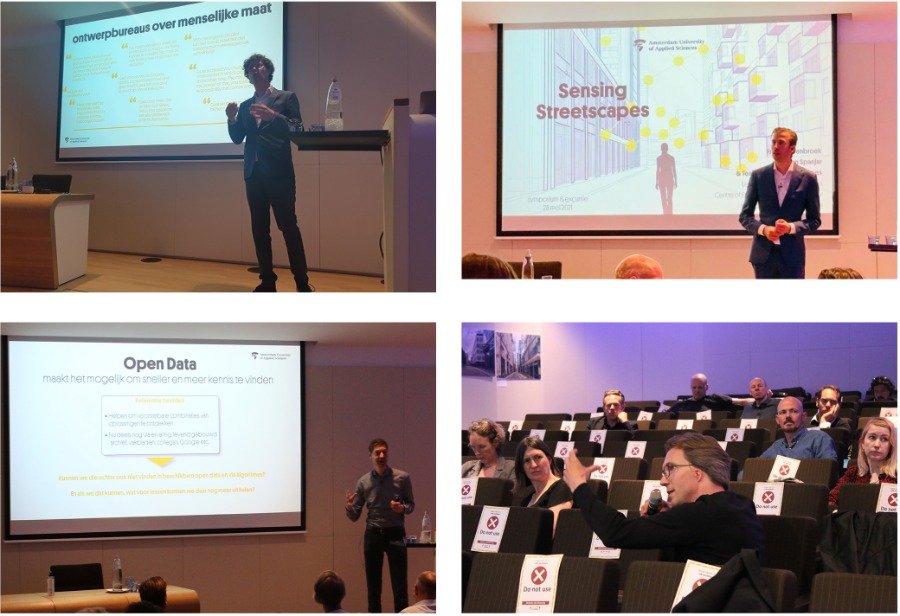
Zo werd ook duidelijk dat bewoners in Londen soms in sociaal isolement verkeren door wonen in hoogbouw op schiereiland Isle of Dogs, vanwege weinig contact met de buren en de straat. Terwijl soortgelijke milieus in Amsterdam, Vancouver en Oslo een ander beeld laten zien vanwege de natuur waarmee zij omringd zijn. ‘De laatste jaren tonen aan dat groen een belangrijke drager voor ontwerp is geworden’, verklaart Gideon Spanjar, projectleider van Sensing Streetscapes. ‘Bewoners van hoogbouw hebben in Vancouver zicht op natuur en de grote en kleine korrel van gebouwen zijn bewust gemengd. Tevens werken zij met ontwerpoplossingen om de hoogbouw voor de voetganger aan het zicht te onttrekken door de gebouwen naar achteren te plaatsen, waarbij het bladerdak van bomen de ruimte subtiel begrensd. Dit noemen we ook wel Vancourism.’
Kijken als gebruiker: neuroarchitectuur ontsluit de beleving
Maar hoe ervaren de bewoners ontwerpoplossingen op ooghoogte zelf? Het nieuwe vakgebied van de neuroarchitectuur biedt de mogelijkheid om hier voor het eerst antwoord op te geven. Iedereen kent immers plekken die fijn aanvoelen en plekken waar je snel weer weg wilt. Met neuroarchitectuur wordt dit proces zichtbaar gemaakt met behulp van eye-trackers en een hiervoor ontwikkeld biometric dashboard. De eye-trackers registreren 30 keer per seconde waar de gebruiker naar kijkt, hoe lang en in welke volgorde. Door vele proefpersonen systematisch verschillende locaties voor te leggen, worden patronen zichtbaar op een heatmap (zie hoofdfoto als voorbeeld).
Uit de veld- en labtests blijkt het belang van wat op ooghoogte wordt ontworpen, zoals de ontwerpers voorspellen. Hierbij werd specifiek duidelijk dat mensen eerst op zoek gaan naar andere mensen. Daarvoor wordt de ruimte gescand op plekken waar je die kan verwachten, zoals balkons, portieken, entrees, fietsenrekken en auto’s. Evenals de functies op de begane grond en het materiaal van gebouwen. En terwijl te veel complexiteit in de straat veel aandacht trekt in negatieve zin, vallen zowel een dichte als een transparante plint minder op. De contouren van een verhoogde plint worden daarbij daadwerkelijk gezien en helpen hoogbouw verschalen. Tot slot werkt een geleidelijke overgang tussen straatwand en straatruimte goed.
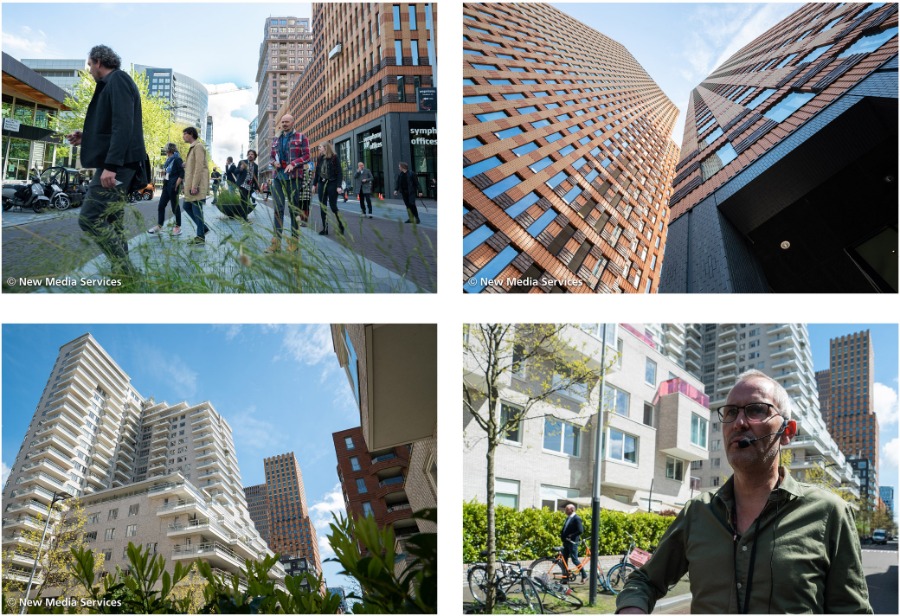
De balans tussen succesvol en niet succesvolle ontwerpoplossingen is subtiel, verklaart lector Suurenbroek. ‘Als we willen dat mensen niet overweldigd raken door hoogbouw, dan zijn neuroarchitectuur-testen gedurende het ontwerpproces van belang. De ontwikkelde methode en patronen die daarmee zichtbaar worden tonen aan dat het ons echt kan informeren over de impact van ontwerpkeuzes.’
Kijken vanuit data: AI ontsluit rijke reeks leerzame locaties
Iedere bouwopgave binnen de bebouwde stad heeft te maken met unieke uitdagingen, maar goed gerealiseerde voorbeelden uit de praktijk kunnen dienen als referentie voor de impact van mogelijke ontwerpoplossingen. Met behulp van AI is binnen het onderzoek een search-engine gebouwd, waarmee via open data vergelijkbare locaties getraceerd kunnen worden. Hiermee helpt AI de ruimtelijk ontwerpers en opdrachtgevers een rijke reeks aan bijpassende referentielocaties te vinden, van Europa tot Noord-Amerika. De mate van hoogbouw, Floor Space Index, Mixed-use is een greep van parameters die je zelf kan instellen.
Suurenbroek: ‘Eenmaal gebouwd bepaalt een ruimtelijk project voor decennia het aanzien en de condities van de plek en omgeving. Juist daarom proberen we met ons onderzoek en de excursie het gesprek tussen de ontwerpers, opdrachtgevers, toekomstige gebruikers en internationale experts te faciliteren. Bovendien vertoont de groei van Amsterdam veel overeenkomsten van die van de meeste andere westerse steden. Ontwerpend onderzoek, neuroarchitectuur, de AI-tool en excursies helpen daarbij. Ontwerpen van het straatniveau valt immers deels tussen verschillende disciplines in.’
Meer informatie
Het eindseminar en de excursie zijn onderdeel van het 2-jarig onderzoeksproject Sensing Streetscapes, waar lector Bouwtransformatie Frank Suurenbroek, hoofdonderzoeker Gideon Spanjar en senior AI-onderzoeker Maarten Groen (lectoraat Resonsible IT) hun resultaten hebben gedeeld. Alsook diverse experts uit Oslo, Vancouver en Londen. Binnen het project werkt een interdisciplinair team van onderzoekers samen met de praktijk en internationale onderzoeksgroepen aan het ontleden van het begrip menselijke maat voor het ruimtelijk ontwerp. Om de resultaten te ontsluiten en de AI-tool open access te gebruiken, is een platform gebouwd: www.sensingstreetscapes.com.
De extreem ambitieuze missie van Amsterdam Smart City: Bruto Menselijk Geluk voor 2030

Onze inzending voor ‘Missie Nederland’ van de Volkskrant (wat kan eigenlijk niet, maar wil je toch voor elkaar krijgen), oftewel een “Moonshot”, is het creëren van Bruto Nationaal Geluk met digitale sociale innovatie. In 9 punten de missie die we samen met Future City Foundation, het G40 Stedennetwerk, BTG Branchevereniging ICT en Telecommunicatie Grootgebruikers hebben ingestuurd.
Om dit te bereiken, moeten we zorgen dat íedereen kan meedoen in onze maatschappij, onze democratie. Ook de groep mensen die we nu niet horen. Met digitale technieken maken we nieuwe verbindingen mogelijk. Zodat je mee kan doen, bij kan dragen, ook als je de deur niet uit kunt, verbaal minder sterk bent of amper tijd hebt. Zo kan iedereen bijdragen aan het eigen geluk én aan dat van een ander.
In 2030 ...
… is geen enkele Nederlander meer digibeet, in plaats daarvan is elke Nederlander digitaal vaardig.
… heeft elke inwoner van Nederland toegang tot hoogwaardig internet. Dat betekent dat elk huis wordt aangesloten op snel vast en mobiel internet en elk huishouden in staat is om apparaten te kopen waarmee toegang mogelijk is. Een goede laptop is net zo belangrijk als een goede koelkast.
… wordt het internet op een nieuwe manier gebruikt. Toepassingen (software en
hardware) worden vanuit de gebruikers gemaakt. Met als uitgangspunt dat iedereen ze kan gebruiken. Programma’s en de daarvoor benodigde algoritmen worden zo geschreven dat ze ten dienste staan van de samenleving en niet van het bigtech-bedrijfsleven.
… heeft elke inwoner van Nederland een ‘self-sovereign-identity’ waarmee ze vrij, binnen de context van hun eigen grenzen, digitaal kunnen opereren en acteren.
… is nieuwe technologie ontwikkeld die de inwoners en bedrijven de kans mee te
denken en beslissen over en mee te ontwikkelen en handelen aan welzijn regio’s,
steden en dorpen.
… hebben alle Nederlandse politici verstand van digitalisering en technologisering.
… is het Nederlandse bedrijfsleven leidend in de ontwikkeling van deze oplossingen.
… zorgt dit alles voor meer welzijn en niet alleen voor meer welvaart.
… is het internet weer van ons.
Laat ons weten wat je ervan vindt in de comments. Lees ook de hele moonshot.
DRIFT and Amsterdam Smart City find each other in partnership
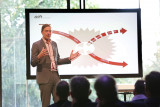
Research institute DRIFT, the Amsterdam Economic Board and Amsterdam Smart City have been working together for some time now. So it only seemed logical to make this union structural.
DRIFT develops and shares transition knowledge with innovative methods and academic training sessions and gets involved in the public debate. ‘Both at DRIFT and within the network of Amsterdam Smart City, we see opportunities and the necessity to change towards a sustainable society. We are happy to enrich this network with our specific knowledge and experience. But also to learn how to shape these kind of new collaborations. The open, learning approach really appeals to us,’ says Gijs Diercks, senior researcher and advisor at DRIFT.
Leonie van de Beuken: 'We are very happy that DRIFT is structurally committed to the Amsterdam Smart City network. We share a passion for empowering others to actively engage in transitions. From residents to entrepreneurs to governments. This way we can achieve tangible results. The knowledge and experience that DRIFT brings in this area is a wonderful addition to our network.'
Wicked Problems; the underlying barriers within transitions
For some time DRIFT has already been part of the team with partners that is developing an approach to tackle so-called 'wicked problems' better together. An approach aimed at revealing and breaking down underlying barriers within transitions. We use new methods for this and connect what we encounter in the implementation with the strategic level.
Picture credit: Edwin Weers
Op zoek: duurzame binding met je buurt
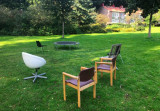
Interview met onderzoeker Anneke Treffers (HvA) over het belang van ‘buurtdragers’ om de binding met de buurt te versterken. Eindpublicatie toont resultaten van onderzoek naar de Couperusbuurt, Amsterdam Nieuw-West.
De Couperusbuurt: een multicultureel stadsdeel in Amsterdam Nieuw-West waar jong en oud samenkomen, maar ook kunnen botsen in opvattingen over wat hun buurt zowel prettig als onprettig maakt. De Hogeschool van Amsterdam (HvA) deed binnen project Ontwikkelbuurten onderzoek naar het belang van ruimtelijke structuren, plekken en programma’s die de binding van bewoners met hun buurt duurzaam kunnen versterken. Ofwel: ‘buurtdragers’. Onderzoekers Ivan Nio, Anneke Treffers en lector Bouwtransformatie Frank Suurenbroek presenteren na ruim twee jaar onderzoek de bevindingen.
De Nederlandstalige muziek van Café Content nabij de Couperusbuurt is eindelijk weer te horen nu de terrassen na lockdown open zijn. Vooral bewoners van het eerste uur komen hier regelmatig samen en dat is tekenend voor de buurt. Het is een voorbeeld van een ‘buurtdrager’ die samenhang en herkenbaarheid biedt, de leefbaarheid versterkt en de buurtbetrokkenheid van bewoners vergroot. Denk ook aan parkjes, hoven, portieken, winkelstrips en andere voorzieningen en faciliteiten in de nabijheid van de eigen woning.
Stedelijke vernieuwing in de Couperusbuurt
Maar niet elke buurtdrager is een voorziening voor iedereen. De Couperusbuurt kenmerkt zich als divers: jong en oud, multicultureel; maar de omgang met de verschillende groepen is laag. Daarnaast kent de buurt ook hardnekkige sociale problemen, waaronder een combinatie van een laag opleidingsniveau, een laag inkomen en een hoge werkloosheid. De veelal portiekwoningen, herkenbaar aan de typerende hovenstructuur van deze na-oorlogse wijk, zijn er erg klein, als gevolg van versnelde bouw na de Tweede Wereldoorlog. Nu anno 2021 wonen in deze kleine woningen een diversiteit aan bewoners en dat levert spanningen op.
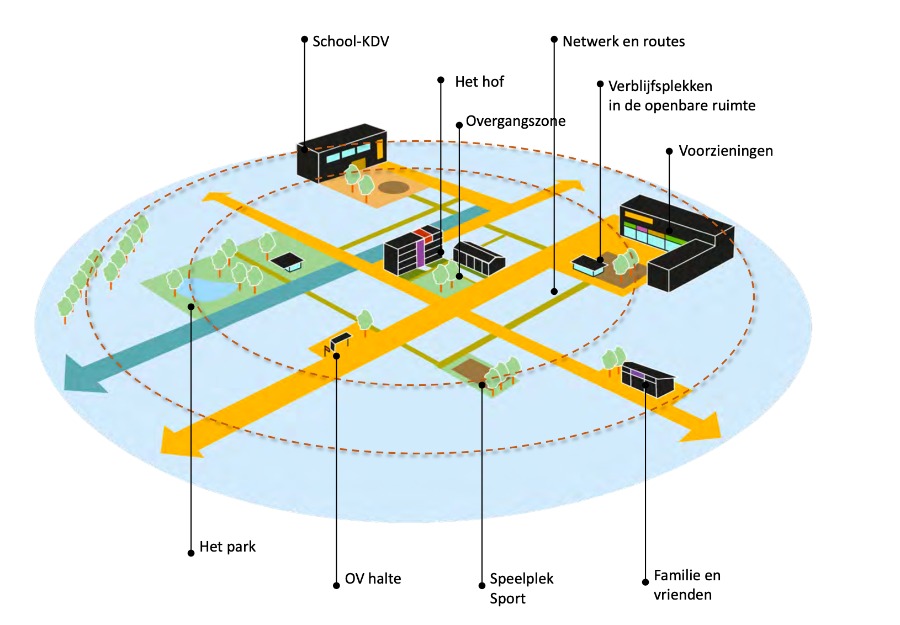
Voorbeelden van buurtdragers.
Maar er is hoop: de Couperusbuurt verwacht stedelijke vernieuwing en staat voor een nieuwe opgave de binding met de buurt en bewoners te versterken. ‘Dan is het nodig om de buurt in te gaan, te ervaren en de bewoners te spreken’, vertelt onderzoekster Treffers. ‘Niet iedereen staat te springen om vernieuwing. Wanneer je een goed overzicht hebt van hoe de buurt individueel beleefd wordt in relatie tot al bestaande buurtdragers, dan kun je pas gaan nadenken over fysieke ingrepen en investeringen die de leefbaarheid en de betrokkenheid bij de buurt kunnen verbeteren.’
Angst bij ouderen
Vooral bij ouderen heerst de angst dat het ‘dorpse gevoel’ door mogelijke ingrepen zou verdwijnen, vertelt Treffers. ‘Ze maken zich druk om de dagelijkse problematiek als grote hopen afval, geluidsoverlast en veiligheid; er zijn hangjongeren en spanningen tussen buren onderling. Maar ook nieuwe bewoners kennen een eigen soort ‘ongeduld’, meer gericht op de toekomst. Kort door de bocht gezegd verwelkomen zij zo snel mogelijk een Starbucks met latte macchiato's.’ En ook door observaties hoe mensen hun woonomgeving gebruiken, komt veel aan het licht: ‘We zien grote stenen pleinen zonder enkele functie, geen kind dat daar speelt. Net als tuinstoelen in het park door een gemis aan bankjes. Zijn die er wel, dan hebben die vaak geen rugleuning; wat moeten ouderen daarmee?’
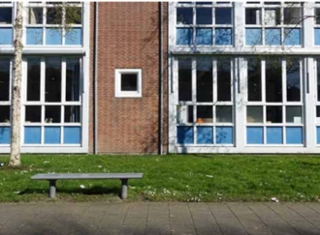
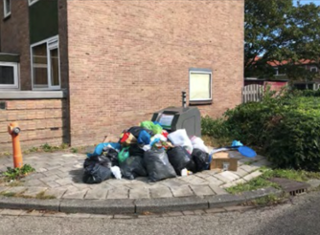
Voorbeelden van dagelijkse problematiek.
Van persoonlijke kaarten naar kansenkaart
De interviews en observaties omtrent bestaande buurtdragers zijn per doelgroep vertaald naar persoonlijke kaarten als een mindmap van de buurt, met daarop gevisualiseerd: routes, locatie van vrienden en familie, positieve en negatieve plekken, dagelijkse voorzieningen en horeca en recreatie. Treffers: ‘Wanneer je die kaarten over elkaar heen legt, zie je al snel de overlappende pijnpunten (vuil, geluidsoverlast, verstening), evenals de plekken met potentie. Met name de Couperusstraat biedt kansen, die loopt dwars door de buurt en kan als drager van de buurt gaan functioneren.’
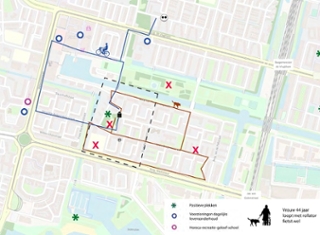
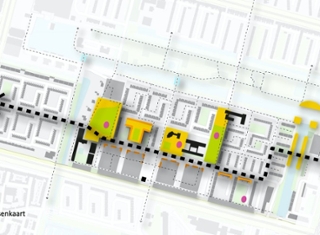
Persoonlijke kaart en kansenkaart - verbinding met de Couperusstraat.
In de eindpublicatie staan aanbevelingen voor gemeente en woningbouwcorporaties hoe de Couperusstraat bestaande en nieuwe buurtdragers aan elkaar kan verbinden. Zo kunnen alle groepen elkaar sneller kruisen, stelt Treffers. ‘Sociale cohesie in de buurt is misschien te hoog gegrepen, maar we kunnen wel publieke familiariteit realiseren. Wat dat is? We zagen iedere dag om 19.00 uur een aantal vrouwen van Turkse komaf op hetzelfde bankje in het park. Elke dag, op hetzelfde moment, kwam een man van in de 70 zijn hond daar uitlaten en maakte een kort praatje. Twee werelden die elkaar doorgaans niet snel ontmoeten in de Couperusbuurt. Die kortstondige ontmoetingen zonder verdere verplichtingen (publieke familiariteit) zorgen voor meer verbinding; zowel sociaal als fysiek.’
LEES DE EINDPUBLICATIE: BUURTDRAGERS IN DE COUPERUSBUURT
Meer informatie
Het project is de eerste verkenning in een langlopend onderzoek naar buurtdragers. Het vormt een waardevolle input voor de planvorming in de ontwikkelbuurten. Het onderzoek is vooral ook een middel om in nadere dialoog met gemeente en corporaties te verkennen naar wat voor soort buurtdragers we eigenlijk op zoek zijn. En waar zouden gemeente en corporaties maar ook andere partijen in moeten investeren in de buurt
Kijk voor meer informatie: projecten Buurtdragers en Ontwikkelbuurten.
Metropolitan Mobility Podcast | Why are Milan's children playing on the street again?

Demetrio Scopelliti (Director of Urban Planning and Public Space, city of Milan) speaks with Geert Kloppenburg and Chris Bruntlett (Dutch Cycling Embassy) about the Piazze Aperte and Strate Aperte Plan that changed the streets and squares of Milan.
In the podcast they talk about:
• How introducing a ping pong table brings people together;
• How you (urban) plan for the unexpected;
• How the city of Milan built 60 kilometers of cycling track in a year.
And see a short video of the project
Interested in more best practices in EU cities? Register here for the Celebrating Cycling Cities event 1st of June, with Stientje van Veldhoven and Frans Timmermans!
Metropolitan Mobility Podcast | Barcelona Superblocks!

How did Poblenou in Barcelona turn into a green oasis? Superblocks!
“I think it is impossible to be against Superblocks.” Silvia Casorran (Deputy Chief Architect at the Barcelona City Council) and Patrick Kappert (member of neighbourhood organisation Collective Superblock Poblenou) speak with Geert Kloppenburg about the Superblocks of Barcelona. They discuss:
- How the Superblocks started
- Why everyone is talking about Superblocks
- How living in a Superblock changed their lives
Interested in more best practices in EU cities? Register here for the Celebrating Cycling Cities event 1st of June, with a.o. Stientje van Veldhoven en Frans Timmermans!
ONLINE LIVECAST (WATCH NOW): Design from Inclusion -Products & Services

In earlier episodes of Designing Cities for All, we have seen that design is everywhere and everything around us is designed. We have also seen that there are flaws in these designs, because what we tend to do in this world is design for the middle and forget about the margins. Wouldn’t we create and build stronger structures for everyone, when we design for the people who are actually living with the failures of our designed products, spaces, and systems?
How green, healthy & sustainable were we really in 2020?
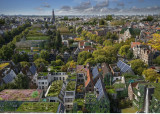
In Amsterdam, a city committed to becoming healthier and more sustainable for its citizens and visitors, we have witnessed a greater sense of togetherness, connectivity and a collective transition towards the sustainable city. This is one of the findings in the latest Monitor report, De Monitor 2020, published by De Gezonde Stad.
In the last year, the global pandemic has challenged our daily routines, our mental and physical well being, our freedom of movement and the ways we interact with our local environment. Every year De Gezonde Stad (The Healthy City) collects the latest facts and figures on Amsterdam’s:
• Green spaces
• Air quality
• Energy use
• Waste production
• Food consumption
These five pillars help its citizens understand how close (or far) we are to a healthy and sustainable Amsterdam. Reflecting on these pillars in the Monitor report, we also learn about the initiatives, achievements and developments blooming across the city, and feel inspired to take action.
So how green, healthy and sustainable were we really in 2020? What was the influence of Covid on the five pillars and what can we do to help Amsterdam’s transition towards sustainability? Using the findings from De Monitor 2020, this blog posts some highlights. And to make it easy, we'll also add these findings in Dutch.
Podcast: Founder of Pakhuis de Zwijger on shaping cities together

In this episode Annick van Rinsum interviews Egbert Fransen: the founder and director of Pakhuis de Zwijger. He set up an unique regional, national and international podium which focuses on bringing people together who want to realise programs that contribute to a more sustainable, fair and future proof society.
Egbert Fransen: “It becomes more interesting if you bring people from different domains and different backgrounds together. My belief is very strong: creation and innovation take place in those places where you have heterogeneous groups of people. It is precisely not being equal, not thinking the same, that brings along innovation."
In these 56 minutes they share stories on:
• His entrepreneurial heart and motives
• The history and development of Pakhuis de Zwijger
• The recent rebranding and his plans for the upcoming 15th anniversary
Podcast #100: Egbert Fransen on shaping cities for everyone, by everyone (in Dutch)
How Strandeiland IJburg democratically develops in a green, social and sustainable island

Strandeiland is the newest artificial island in the IJburg archipelago in the IJmeer, on the east side of Amsterdam. The island is currently being constructed. With 8,000 homes, Strandeiland is one of the largest future urban districts in Amsterdam.
Involving citizens in urban development processes
How can citizens gain more control and ownership in the development of urban areas? To make the process of shaping the development plans of Strandeiland more democratic, the DemoS project was launched in October 2018. DemoS – democratic Beach Island – is part of the Participation Plan for this area and has been running for two years.
The Strandeiland project leader, municipal innovation team (CTO), the local municipality (Stadsdeel), three IJburg residents, researchers, and students of MSc MADE participated in the living lab project DemoS from 2018 -2020.
The aim of the participation trajectory was threefold:
- To set up a novel way of collaboration between civil servants and citizens around the participation processes of the design and development of Strandeiland.
- To share the gained insights transparently to inspire other citizens and civil servants.
- To grow a community of potential future Strandeilanders.
The participation team was loosely established on the principles of a living lab with the innovative focus on making city-making processes more inclusive and democratic. This is the first time in Amsterdam that civil servants and citizens work together in this formal agreement whereby citizens are engaged in creating the participatory processes. Continue reading about the results >>
NEW EUROPEAN BAUHAUS PARTNERSHIP FOCUSES ON A SUSTAINABLE FUTURE

The Amsterdam University of Applied Sciences (AUAS) has become an official partner of the European Commission's New European Bauhaus (NEB) initiative, which aims to transform the European Commission's sustainability agenda into real solutions that contribute to a sustainable and inclusive society. This partnership is coordinated via the AUAS’s Centre of Expertise for Creative Innovation (CoECI), a collaboration between four Amsterdam-based higher education institutions that is headed by AUAS. By participating in this initiative, AUAS and CoECI will focus on helping to create a sustainable and inclusive society through creative innovations with a broad network of partners.
New European Bauhaus stems from the Horizon 2020-funded European Green Deal, the latter of which aims to accelerate Europe's recovery from the coronavirus crisis by turning green challenges into innovation opportunities. Within the Green Deal, AUAS is already working on various project proposals with international partners that aim to help create a climate-neutral Europe by 2050 via our collaborative applied research. These EU initiatives align well with our new 3D strategy at the Amsterdam University of Applied Sciences, which prioritises sustainability as one of the three key domains for our institution in the years ahead, alongside diversity & inclusion, and digitalisation.
Beautiful, sustainable, together
Via the motto ‘beautiful, sustainable, together’, AUAS partners with New European Bauhaus New European Bauhaus (NEB) draws inspiration from Bauhaus movement 100 years ago and the belief that design can be a force for societal progress. To quote the project: “We want to create a design movement integrating three dimensions: sustainability (including circularity), quality of experience (including aesthetics) and inclusion (including affordability). Showing that creativity is in finding affordable, inclusive and attractive solutions for our climate challenges.”
The interdisciplinary nature of the initiative presents an excellent opportunity for the entire AUAS, and the creative sector in particular, to participate and help shape the future. CoECI supports this plan and, together with its network of partners both inside and outside the AUAS, will use its imagination and develop innovative concepts that contribute to the sustainable transition.
Activities
In the coming months, CoECI will join other partners in the Netherlands and Europe to discuss ideas for a sustainable future and how the creative sector can contribute to it. It will also review how faculties across the AUAS can collaborate on this great challenge from their own areas of expertise: from social questions and technical innovations to design perspectives.
CoECI brings together creative businesses, citizens, science and education in the Netherlands and Europe, to collectively create proposals and ideas for a sustainable Europe. The NEB initiative is now in the 'Design phase' and will kick off the 'Deliver phase' in September 2021. The AUAS hopes to be selected for this, which would see it set up and implement collaborative pilot projects. This will be followed by the 'Disseminate phase'. More information, including about the activities, will soon be available on the CoECI website (currently only available in Dutch).
Contact
Mareile Zuber, project developer at CoECI and responsible for the European partnership, is the contact person for questions/remarks/ideas and proposals regarding New European Bauhaus. You can reach her directly via m.a.zuber@hva.nl.
In addition to coordinating activities for New European Bauhaus, Mareile will focus on building bridges between CoECI/AUAS and other European consortia. This could include, for example, applications to European financing programmes such as Horizon Europe, Creative Europe and Digital Europe.
About the Centre of Expertise for Creative Innovation
The Centre of Expertise for Creative Innovation (CoECI) is the national knowledge and innovation network for the creative industry. CoECI uses art, media, technology and design to create a sustainable and inclusive urban society. These activities contribute to partnerships, both commercial and non-profit, between education and the professional field. In this way, CoECI connects research and talent with companies, social organisations and communities.
CoECI is a partnership coordinated by the Amsterdam Universities of Applied Sciences with three other institutions: the Amsterdamse Hogeschool voor de Kunsten (AHK) and Hogeschool Inholland (founding partners); as well as the Gerrit Rietveld Academy, which joined the collective in 2019. This collaboration was originally launched under the name Amsterdam Creative Industries Network (ACIN). CoECI covers the entire chain of artistic innovation: from experimental research to concrete interventions.
More information about New European Bauhaus is available via the website of the European Commission.
Interview met Marco Te Brömmelstroet, prof Urban Planning (UvA)

Interview met Marco Te Brömmelstroet, prof Urban Planning (UvA) en co-auteur boek 'Recht van de Snelste'. ‘Reistijdwinst is DE norm onder alle uitroeptekens qua mobiliteit, maar vragen amper naar de onderliggende aannames’.
(Herhaling vanuit #BNR podcaststudio: opnieuw relevant dit interview): https://bit.ly/Brömmelstroet
Metropolitan Mobility Podcast with Karen Vancluysen (Polis Network)
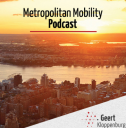
How can local governments deal with (technological) innovations? Listen to the #podcast with Karen Vancluysen of POLIS Network: https://bit.ly/mobilitypod
Podcast #wandeltijdensjewerkdag
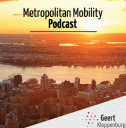
In het kader van #wandeltijdensjewerkdag op 8 april georganiseerd door Wandelnet, een podcast over lopen voor tijdens het wandelen: http://bit.ly/podcastlopen
New podcast out !
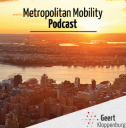
De Gouden Piramide ging in 2016 naar een bijzondere plek voor jonge mensen: Xenia Huis met een Hart Hospice en Logeerhuis Leiden. Luister naar het indrukwekkende verhaal van oprichtster Jacqueline Bouts: https://bit.ly/mobilitypod
Stay up to date
Get notified about new updates, opportunities or events that match your interests.

